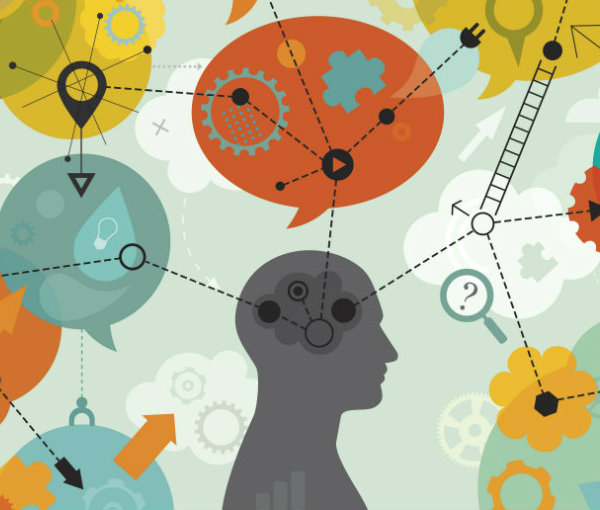Faculty of the Mind
Michael Kahana, Professor of Psychology and Director of the Computational Memory Lab, is working with his collaborators to improve patients’ memories.
When Michael Kahana and his collaborators landed on the idea of using brain implants to track brain activity in patients who are awake and alert, it was akin to a research goldmine.
The research is integral to the Restoring Active Memory (RAM) project, a grant initiative funded by DARPA (Defense Advanced Research Projects Agency) awarded to Kahana in 2014. RAM is a centerpiece of Penn Arts and Sciences’ Harnessing the Power of the Brain initiative, which seeks to bring together researchers from myriad disciplines to decipher the complex relationship between brain activity and the vastness of human intelligence and behavior. The long-term goals of the RAM project are to deliver new treatments to those who have experienced a traumatic brain injury, such as veterans returning from combat. The hope is that the research might also be used to help patients with a broad range of ailments, like Alzheimer’s disease.
The research team makes up one of half a dozen or so labs around the world that are pursuing direct human brain recording in order to understand memory. “Early in my career I had the incredible fortune of meeting a talented young neurosurgeon, Dr. Joseph Madsen of Children’s Hospital, Boston. Joe invited me to visit the epilepsy monitoring unit where I met patients whose seizures were being monitored and evaluated with surgically implanted electrodes,” says Kahana, a professor of psychology and director of the Computational Memory Lab. “I remember quite vividly watching one of the teenagers play a Nintendo video game while we observed the patient’s brain activity recorded from more than 100 electrodes on a monitor in an adjoining room. I said, ‘This is incredible, who is analyzing these data?’ I then learned that the data were routinely deleted at the end of [each session] due to the very limited storage capacity of computers in the 1990s.”
After this serendipitous encounter, Kahana began an intensive 20-year program of research to use invasive neural recordings to study the brain’s signals underlying human memory function. These studies revealed the critical importance of neural oscillations both for human spatial and verbal memory. During the subsequent 20 years, Kahana and has students have intensively studied the neural basis of human memory in neurosurgical patients. Direct electrical recordings from the human brain not only expose which regions give rise to memory-related signals—they also reveal the precise timing and character of those signals, revealing a symphony of brain activity that takes place whenever you store or retrieve information.
In fall 2013, Kahana learned about the ambitious DARPA program and assembled a team, led by Penn but including eight other leading medical research centers, and commercial-partner Medtronic, to study novel approaches to using brain stimulation to boost memory. Kahana’s team had already identified reliable methods for decoding when memory would be likely to succeed or fail.
Kahana surmised that if he could decode these signals rapidly, they could be used to determine when, where, and how to stimulate the brain to boost memory. The key idea, according to Kahana, is that “memory is highly variable from moment to moment and day to day. By knowing whether the memory system is functioning well or poorly, we can precisely tune the parameters of brain stimulation to be helpful rather than harmful.” To accomplish the “when,” it is critical that to stimulate the brain during periods when it is not working at its optimal level, such as a failure of memory. “You don't want to disturb the brain when it's working well,” says Kahana, who was this year's recipient of the Warren Medal, the highest honor for experimental psychology. “You want to coax it out of the bad state and into a good state.”
To determine exactly when to stimulate the brain, Kahana’s team developed closed-loop systems that could deliver precisely timed stimulation to specific brain structures just as memory was predicted to fail. “When we applied stimulation in this manner, we were able to reliably boost recall performance by more than 15 percent,” Kahana says. This degree of change is equivalent to the decline in memory observed over two years of progression of Alzheimer’s disease, suggesting that closed-loop stimulation approaches may one day be used to treat this condition. These findings, recently published in Nature Communications, have been widely covered in publications such as The New York Times and National Public Radio.
“We have a lot more testing to do, but we believe that closed-loop stimulation approaches could be effectively used to treat memory loss in a variety of neurological conditions” Kahana says.
When it comes to working with the study participants, Kahana says the patients he and his collaborators oversee are a very special group. “This is an incredibly giving, empathetic set of people who want to do everything that they can to reduce the suffering of others. They participate in these experiments and teach us how the brain works, and their contribution is invaluable.”



